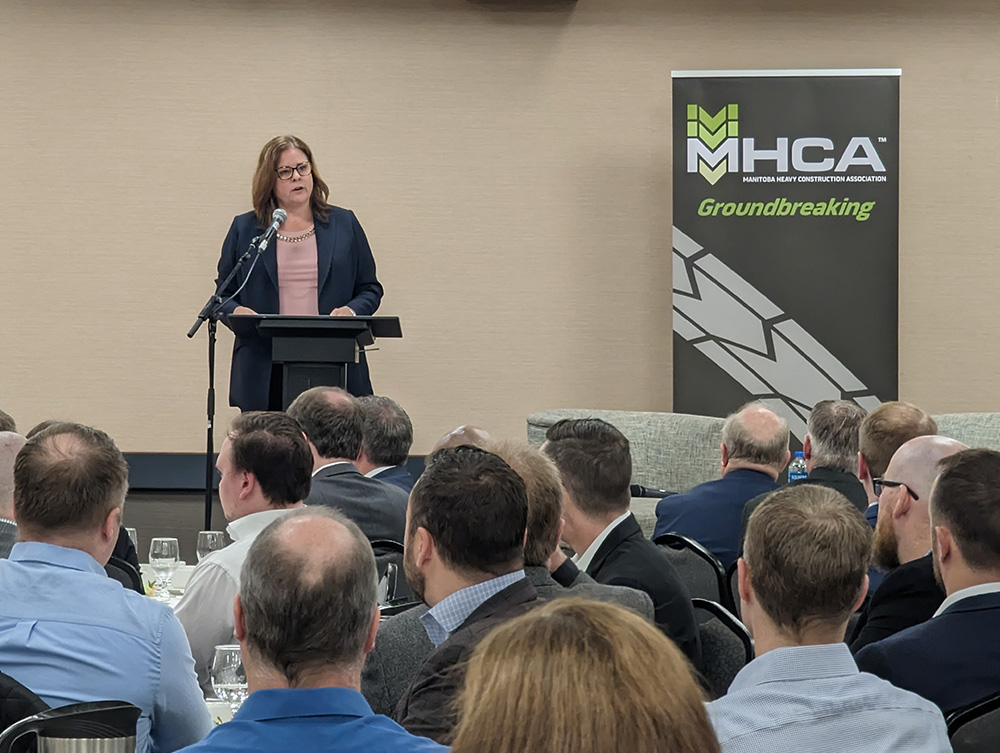Manitoba premier champions trade corridor investment for national support

Manitoba Premier Heather Stefanson said she will work with her premier colleagues to solidify support for a National Plan for Trade Corridor Infrastructure at July’s Council of the Federation meeting, which she will chair in Winnipeg.
“Our government is proud to advocate for trade enabling infrastructure at the national level,” Premier Stefanson said at the MHCA Breakfast with the Leaders event April 11.
She noted that in January, she “joined business and industry association leaders from across Canada – spearheaded by Chris Lorenc and the Manitoba Heavy Construction Association – to call on the federal government to develop a National Infrastructure Strategy.
“In my role as Chair of the Council of the Federation representing all Premiers across Canada, Manitoba will be a leader in this initiative and national strategy moving forward. Together, we will get our commodities and products to market more efficiently than ever before.”
Stefanson at the January meeting with the Canadian Chamber of Commerce, Business Council of Canada, Canadian Construction Association, Canada West Foundation and the Western Canada Roadbuilders & Heavy Construction Association, firmly committed to working with her premier colleagues on the Council of the Federation to see a trade corridor strategy adopted nationally.
This includes championing a call for the federal government to adopt the strategy, building on the foundational steps outlined in the Canada West Foundation report (May 2022) From Shovel Ready to Shovel Worthy. The report notes Canada is alone among its trade nation peers to not have adopted. A strategy would lay out the criteria for and prioritization of the trade infrastructure projects for significant investment, as well as lining up 20 or 30 years of projects to anticipate the needs of future growth in global trade markets.
Following on the heels of the breakfast address, Manitoba Transportation and Infrastructure Minister Doyle Piwniuk announced the signing of a memo of understanding with his counterparts in Alberta and Saskatchewan, to work together on planning and investment in trade routes across the jurisdictions.
“Manitoba’s unique gateway and hub initiatives cannot develop in isolation, that is why external co-operative partnerships will leverage our initiatives for success,” said Piwniuk.
“With similar trade and transport access such as distance to markets, reliance on international ports and railway services, and similar commodity basis, Saskatchewan and Alberta are natural partners to work with on improving trade through transportation.”
The MOU will promote co-operation on matters such as improving joint highway planning, efficiency measures supporting trade, joint advocacy on federal regulatory and funding issues impacting prairie transportation-based trade, and assessing private-sector investments and Indigenous partnerships in improving or developing new economic corridors, the Manitoba government news release said.
At the breakfast, Stefanson once again stressed the importance of trade and investment in trade infrastructure to Manitoba’s and Canada’s prosperity.
“Manitoba is transforming into a globally recognized trade and transportation hub,” she said, noting the billions of dollars her government has lined up for infrastructure investment in the provincial trade routes strategy, including funding for CentrePort Canada South, the rail line to Churchill, bringing the Perimeter to freeway status, twinning the length of the TransCanada Highway from Falcon Lake to the Ontario border and working on Highway 75.
The minimum $500 million per year for five years budgeted for highways capital will feed into the trade routes investment strategy.
“We have earmarked most of this funding to improve Manitoba’s capacity for international trade at a critical time for the global economy.”
Winnipeg Mayor Scott Gillingham, also at the breakfast, told reporters he and Stefanson spoke about the city’s plans to fund design studies of extending Chief Peguis Trail and widening Route 90, both critical trade corridors, linking up to CentrePort Canada.
“Investing in trade infrastructure is critical to ensuring our economy continues to grow,” Gillingham said.
MHCA President & CEO Chris Lorenc said the premier’s address this morning is further evidence she understands the critical role that trade plays in economic growth and is committed to investing in the corridors and gateways that move people to jobs and goods to market.
“Premier Stefanson was quick to commit to leading her colleague premiers, at the Council of the Federation and by the investments made here in Manitoba, in a campaign to see the federal government adopt a national trade infrastructure strategy,” said Lorenc, who is also President & CEO of the WCR&HCA.
“This movement is picking up significant support across the offices of Premiers and among national business groups. Growth in trade is our best economic leg forward.”












